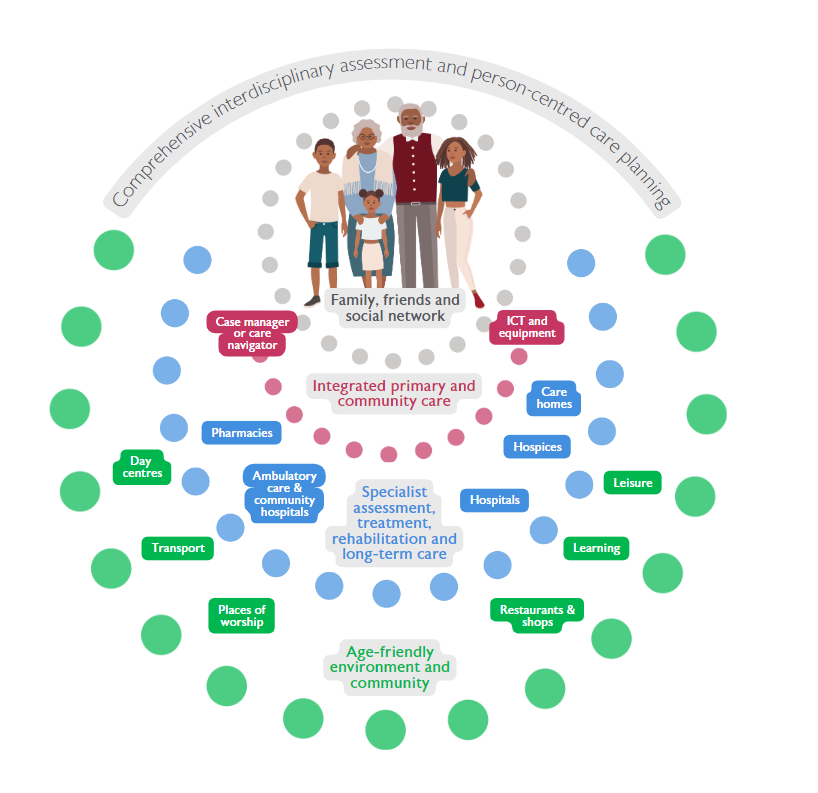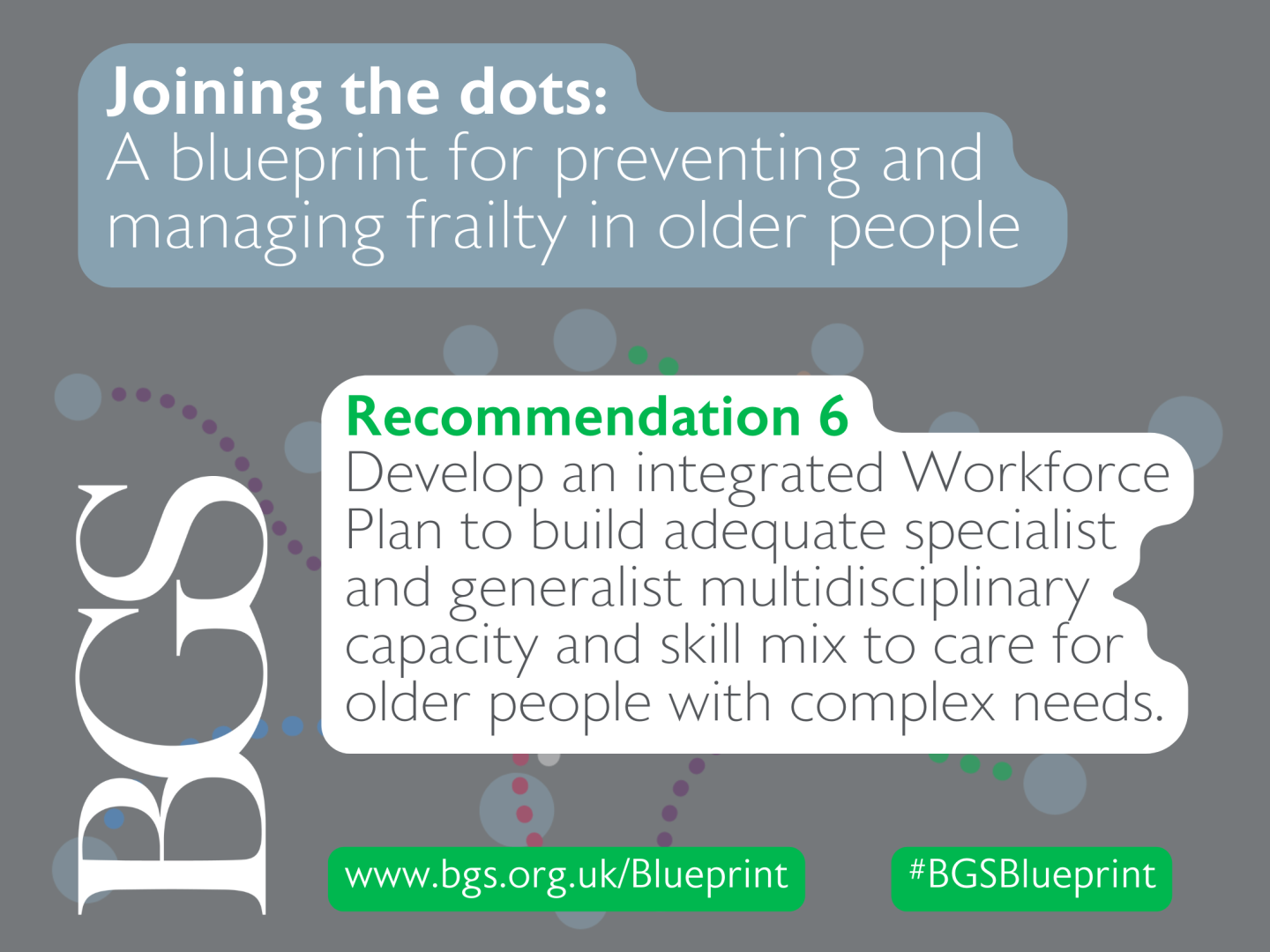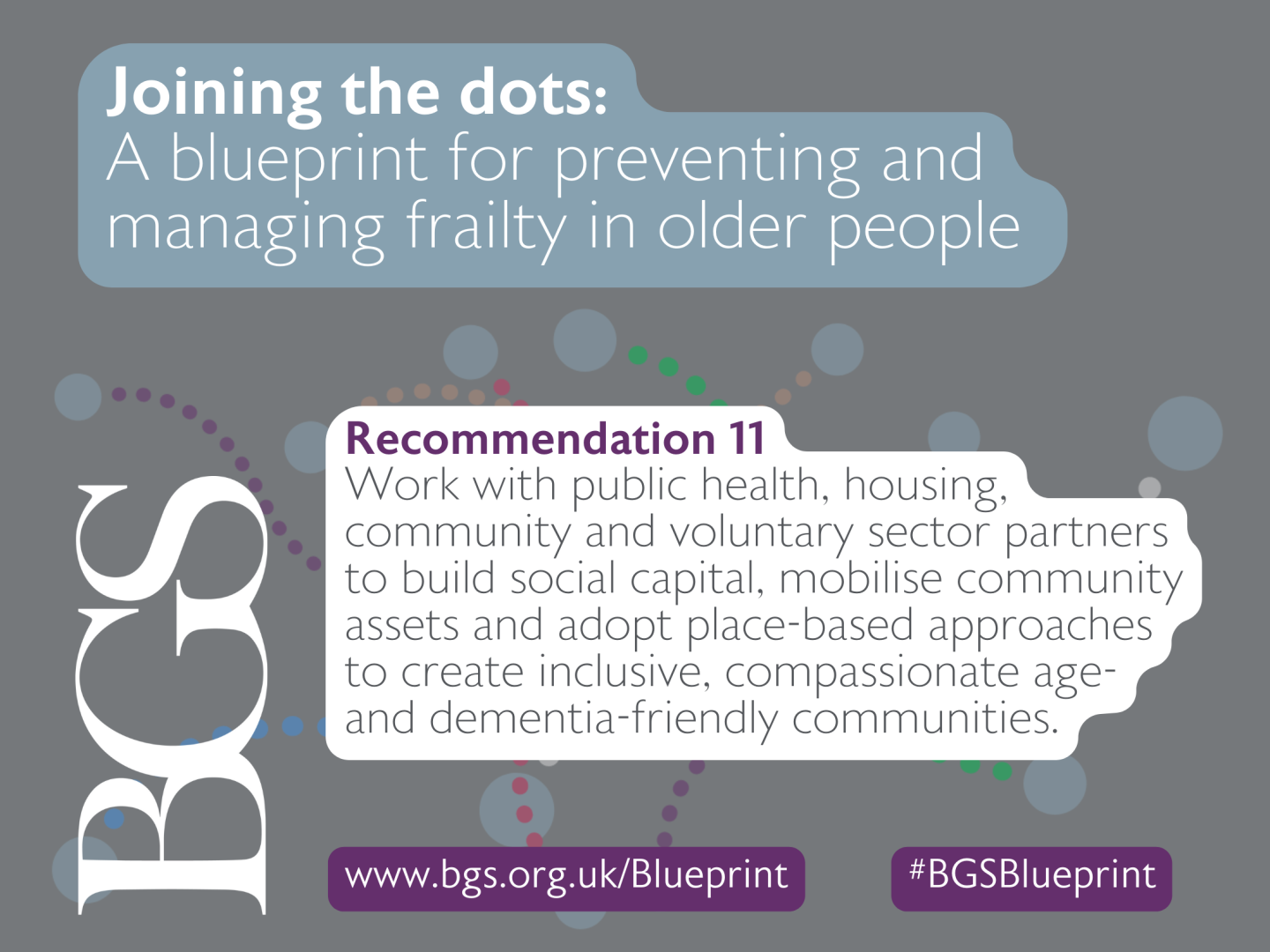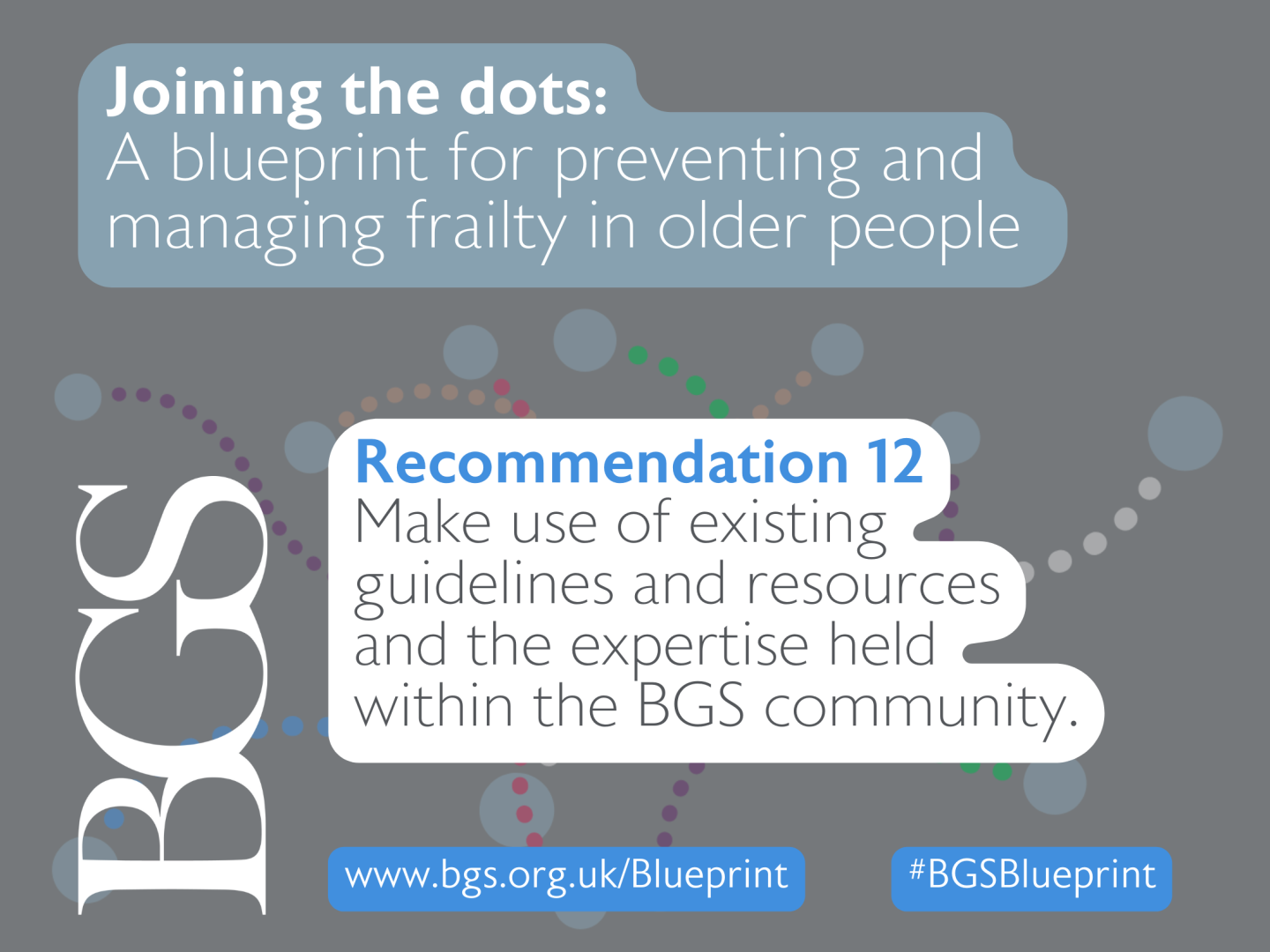This chapter introduces our Blueprint with a foreword by our President and Honorary Secretary/lead author, an executive summary and a roundup of our 12 recommendations.
Foreword
Older people use the NHS and social care services more than any other age group and as the population continues to age, the demand for such services will continue to grow. People are living for longer with more complex conditions in older age and often require specialist care from a range of professionals across the multidisciplinary team. At the same time, new organisations across the UK are taking on responsibility for commissioning health and social care services and it is essential that they get this right for older people. If services work for older people, the biggest user group for health and social care, they are more likely to work for everyone else.
|
Professor Adam Gordon |
Professor Anne Hendry |

Executive summary
Older people have diverse, often complex, needs, and health and care services need to respond to that complexity and heterogeneity. This document aims to be a Blueprint to show what good-quality age-attuned integrated care for older people can look like.
BGS members around the country report differences in the way that older people’s health and care is delivered in their area. Variations range from different ways urgent and crisis care is delivered to whether or not there is a specialist outpatient clinic or day hospital for older people. Systems should of course plan and deliver care and support that meets the needs of the population they serve. However, as the population ages, it is vital that health and care commissioners address the needs of older people living with frailty. Frailty affects up to half of the population aged over 852 and costs UK healthcare systems £5.8billion per year.3 Around 47% of hospital inpatients aged over 65 are affected by frailty.4 But frailty is not an inevitable part of ageing, and putting in place measures to slow its onset or progression should be a priority for every commissioner across the UK. Prevention and reversal of frailty enables people to live independently for longer and helps to reduce demand for emergency care and long-term support.
With this in mind, the BGS has set out seven ‘system touchpoints’ that should be included when planning and commissioning health and social care for older people. The BGS was pleased to participate in the core group that steered the I’m Still Me project.5 We have taken inspiration from this narrative for coordinated support for older people in developing the Blueprint and have woven the I’m Still Me statements through the touchpoints to create person-centred outcomes.
It is important to note that this is not a pathway. Care rarely takes a pathway approach. Many older people will simultaneously require care or support drawn from several of the touchpoints described. Others will only experience a few touchpoints or may have repeated contact with one. Every individual is different. It is important that commissioners invest in all of these elements together to create a comprehensive ‘wrap around’ system of care that supports older people to age well and live well at home for longer.
Enabling independence, promoting wellbeing
I am able to stay healthy for longer and supported to be independent in an age friendly community where I can maintain social contact as much as I want, take part in activities that are important to me, and am recognised for what I can do rather than assumptions being made about what I cannot.
Population-based proactive anticipatory care
I can plan my care with people who work together to understand me and my carer(s), allow me control, and bring together services to achieve the outcomes important to me. I can make my own decisions, with advice and support from family, friends or professionals if I want it.
Integrated urgent community response, reablement, rehabilitation and intermediate care
If I fall or become acutely unwell, I can get the right help at the right time from the right person at home, or closer to home, and a team of professionals coordinate my care and support my recovery.
Frailty-attuned acute hospital care
My risk of poor outcomes and support needs are identified and addressed throughout my hospital stay. Those who matter to me are recognised as being key to my independence and quality of life.
Reimagined outpatient and ambulatory care
I have more joined-up care and can see the right people for the right amount of time in a single clinic visit.
Enhanced healthcare support for long term care at home and in care homes
I can build relationships with people who support me. All my health and care needs are considered together and my care and support help me live the life I want to the best of my ability in the place I call home.
Co-ordinated, compassionate end of life care
At the end of my life I, and those who matter to me, am supported to experience a good death in my preferred place of care.
Our 12 recommendations
Recommendation 1
Demonstrate strong system leadership that creates a shared vision for healthy ageing and preventing and managing frailty.
Recommendation 2
Appoint a senior officer or non-executive Board member with a specific role to seek ongoing assurance on the quality of health and social care for older people and their carers.
Recommendation 3
Publish baseline, then annual, State of Ageing reports on system-wide outcome indicators related to care for older people including feedback from patients and carers to reflect their experience.
Recommendation 4
Develop a system-wide strategy and costed implementation plan for a population health approach to the prevention and management of frailty, including a specific focus on dementia and falls.
Recommendation 5
Commission or deliver inter-professional education aligned with the Skills for Health Frailty Core Capabilities Framework and which builds capacity for Comprehensive Geriatric Assessment, quality improvement and integrated practice in all disciplines across the system.
Recommendation 6
Develop an integrated Workforce Plan to build adequate specialist and generalist multidisciplinary capacity and skill mix to care for older people with complex needs.
Recommendation 7
Protect and preserve the right to rehabilitation for all older people who need it, in line with the principles outlined by the Community Rehabilitation Alliance.
Recommendation 8
Publish an older people equality and diversity impact assessment and action plan.
Recommendation 9
Engage and involve older people, carers and communities as equal partners with health and social care professionals in co-design, delivery and monitoring the impact of these services and support.
Recommendation 10
Provide support to enable the lived experience of older people and carers, including those with dementia and mobility, sensory or communication needs, to inform quality improvement and assurance.
Recommendation 11
Work with public health, housing, community and voluntary sector partners to build social capital, mobilise community assets and adopt place-based approaches to create inclusive, compassionate age- and dementia-friendly communities.
Recommendation 12
Make use of existing guidelines and resources and the expertise held within the BGS community.

Navigating this report
This Blueprint aims to set out how organisations taking on responsibility for integrated health and social care services for the first time can organise their services to best meet the needs of the older people within their communities. We start by explaining why we have chosen to publish this document at this time and who we consider our audience. In this chapter we collate twelve recommendations for systems which are included within the main text of our Blueprint.
Chapter two looks specifically at the population that this Blueprint applies to – older people, including those living with frailty. In this chapter, we outline how we have tried to keep older people at the heart of this document and set out what works for older people from the perspective of best practice and what matters to older people. We discuss the rapidly ageing population, explain why frailty is of particular significance and pose some challenges for system leaders to consider. This chapter also discusses population approaches to frailty in the UK, including the electronic frailty index, and outlines the particular workforce challenges facing older people’s healthcare.
Chapter three turns to system touchpoints, reflecting where there is evidence and pointing to case studies that can support systems to make the required changes. This chapter looks specifically at seven interdependent areas of older people’s healthcare: enabling independence, promoting wellbeing; population-based proactive anticipatory care; integrated urgent community response; reablement, rehabilitation and intermediate care; frailty-attuned acute hospital care; reimagined outpatient and ambulatory care; enhanced healthcare support for long term care at home and in care homes; and co-ordinated, compassionate end of life care.
We conclude with an offer to help system leaders across the UK to commission the right care for their older populations with support from the resources and expertise of the BGS.












